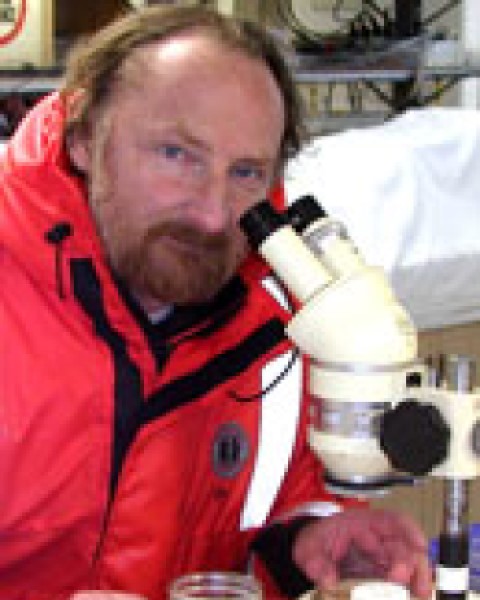
Russell Hopcroft
Chair, Department of Oceanography
Professor
Biological Oceanography
Marine Biology
Marine Invertebrates
College of Fisheries and Ocean Sciences
120 O'Neill
Fairbanks, AK 99775-7220
907-474-7842
907-474-5383
907-474-7204 (fax)
rrhopcroft@alaska.edu
Office Hours
Daily
3:15–4:00 pm
120 O'Neill
- Trophodynamics
- Midwater ecology
- Zooplankton
- Arctic and subarctic ecosystems
Jaspers, C., Hopcroft, R.R., Kiorboe, T., Lombard, F., Lopez-Urrutia, A., Everett, J.D. and Richardson, A.J.
2023. Gelatinous larvacean zooplankton can enhance trophic transfer and carbon sequestration.
Trends Ecol. Evol. https://doi.org/10.1016/j.tree.2023.05.005
Cotea Islas, H.M. and Hopcroft, R.R. 2023. Abundance, composition and distribution of predatory gelatinous zooplankton
in the Northern Gulf of Alaska. J. Plankton Res., 45, 693-708.
Cushing, D.A., Kuletz, K.J., Sousa, L., Day, R.H., Danielson, S.L., Labunski, E.A.,
and Hopcroft, R.R. 2023. Differential response of seabird species to warm- and cold-water events in
a heterogenous cross-shelf environment in the Gulf of Alaska. Mar. Ecol. Prog. Ser. https://doi.org/10.3354/meps14239
Ducklow, H.W., Cimino, M., Dunton, K.O., Hopcroft, R.R., Ji, R., Miller, A. and Sosik, H.M. 2022. Marine coastal pelagic ecosystem responses
to climate variability and change. Bioscience, 72, 827-850.
Suryan, R. M. and 47 others. 2021. Ecosystem response to a prolonged marine heatwave
in the Gulf of Alaska. Nature Sci. Rep. 11: 6235
Arimitsu, M. and 21 others. 2021. Heatwave-induced synchrony within forage fish portfolio
disrupts energy flow to top pelagic predators. Global Change Biol. 27:1859-1878.
Bucklin, A. and others. 2021. Toward A Global Reference Database of COI Barcodes for
Marine Zooplankton. Mar. Biol. 168: 78.
My primary interests focus on the composition, production and energy flow of pelagic
ecosystems. More simply, my research explores the questions "How do planktonic communities
work," "How much energy do they process," "Who’s really important," "How do communities
vary temporally and spatially," and increasingly "How do communities change in response
to climate." I am also recognized as a taxonomic authority on several groups of zooplankton
globally, and for Arctic zooplankton biodiversity in general.
My research efforts have often focused on determining the rates of growth and egg
production for the dominant zooplankton (copepod and euphausiid crustaceans), such
as in the Gulf of Alaska within the Northeast Pacific GLOBEC program. The ultimate
purpose of this research is to establish the rates of secondary production for Alaska
waters to help constrain estimates of production of higher tropic levels.
A large portion of my research has focused on the Arctic Ocean. With NOAA’s Ocean Exploration program an ROV was used in conjunction with traditional plankton nets to explore the full spectrum of zooplankton including the more fragile gelatinous plankton in the western Arctic in 2002, 2005 and 2016. From 2004–2018 I have been involved in numerous projects assessing zooplankton communities in the Northern Bering, Chukchi and Beaufort Sea shelves, including environmental baseline studies for industry. I continue working to consolidate zooplankton data throughout the Arctic and model the distribution of key zooplankton species over the past decades.
My second research focus is Long-term Ecological Research (LTER) observation program in the Northern Gulf of Alaska (NGA). Begun in 1997–2004 as part of the GLOBEC program, it is now funded by a consortium of NPRB, AOOS, EVOSTC, and NSF. The goal of this effort is to understand the mechanisms that lead to the high production and resiliency of this subarctic ecosystem, and how this varies from year to year and over decades. Ongoing efforts use a combination of classical morphological analyses, image analysis, molecular approaches (i.e. barcoding, metagenomics, transcriptomics), and rates measurements.


